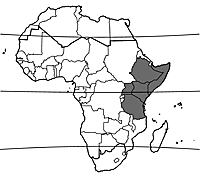Buckollia volubilis (PROTA)
Introduction |
| General importance | |
| Geographic coverage Africa | |
| Geographic coverage World | |
| Vegetable | |
| Essential oil / exudate | |
| Medicinal | |
| Food security | |
Buckollia volubilis (Schltr.) Venter & R.L.Verh.
- Protologue: S. Afr. J. Bot. 60(2): 97 (1994).
- Family: Asclepiadaceae (APG: Apocynaceae)
Synonyms
- Curroria volubilis (Schtr.) Bullock (1954).
Origin and geographic distribution
Buckollia volubilis occurs in Ethiopia, Somalia, Kenya, Uganda and Tanzania.
Uses
In Kenya a decoction of the stem bark is taken to ease childbirth and to treat malaria. In Tanzania pounded tuber in water is drunk as a galactagogue. It is also given to cows to increase milk production.
The latex is used by the Turkana people as glue to fix spearheads to the shaft. The aerial parts are sometimes eaten as a vegetable.
Botany
Small, twining liana up to 4 m long; several stems arising from large tuber; stem up to 1 cm in diameter, bark greyish brown, short hairy when young; latex in all parts. Leaves fascicled on stunted lateral shoots, opposite on normal shoots, simple and entire; petiole 1–3 mm long; stipules absent; blade narrowly to broadly obovate, 35–50(–65) mm × 7–15(–24) mm, base cuneate, apex acute to obtuse or dented, short-hairy. Inflorescence a few-flowered monochasium or dichasium, peduncle 2–8 mm long, bracts narrowly triangular, c. 1 mm long. Flowers bisexual, regular, 5-merous, fragrant; pedicel 1–2 mm long; sepals (broadly) ovate, up to 2 mm long, apex acute, brownish, white long-hairy; corolla with tube c. 1 mm long, lobes narrowly triangular to narrowly ovate, 5–7 mm × 2–3 mm, apex acute to obtuse, glabrous, greenish to yellowish, glandular swelling rounded, dull red-brown; corona lobes filiform, 4–9 mm long, pink, yellow to brownish at base; interstaminal disks between corona lobes, lobular; stamens with filaments c. 1 mm long, anthers c. 1 mm long, fused to stigmatic head, pollen tetrads tetrahedral or rhomboidal, pollen carrier spoon-shaped; ovary semi-inferior, 2-celled, style columnar, c. 1 mm long, stigmatic head c. 1.5 mm long. Fruit a pair of spreading follicles, each narrowly cylindrical, 14.5–19 cm × 6–8 mm, apex blunt, greyish brown, densely warted, many-seeded. Seeds narrowly ovoid, 5–7 mm × c. 2 mm, smooth, with a coma of whitish hairs, 25–30 mm long.
Buckollia belongs to subfamily Periplocoideae and comprises 2 species, Buckollia volubilis and Buckollia tomentosa (E.A. Bruce) Venter & R.L.Verh. Buckollia tomentosa occurs only in northern Uganda and southern Ethiopia and is relatively rare. Buckollia closely resembles Tacazzea and Periploca.
Ecology
Buckollia volubilis is widespread and common, and occurs in Commiphora- Acacia shrub savannah, and also on mountain slopes and among rocks, at 400–1300 m altitude. The annual rainfall is between 250–600 mm. North of the equator Buckollia volubilis flowers from March–November, and south of the equator from October–April.
Genetic resources
Buckollia volubilis is relatively common in East Africa and therefore not threatened by genetic erosion.
Prospects
Buckollia volubilis will remain of minor importance only, unless chemical and pharmacological analyses reveal new possibilities.
Major references
- Neuwinger, H.D., 2000. African traditional medicine: a dictionary of plant use and applications. Medpharm Scientific, Stuttgart, Germany. 589 pp.
- Venter, H.J.T. & Verhoeven, R.L., 1994. Buckollia, a new genus in Periplocaceae. South African Journal of Botany 60(2): 93–98.
Other references
- Morgan, W.T.W., 1981. Ethnobotany of the Turkana: use of plants by a pastoral people and their livestock in Kenya. Economic Botany 35(1): 96–130.
- Venter, H.J.T. & Verhoeven, R.L., 2001. Diversity and relationships within the Periplocoideae (Apocynaceae). Annals of the Missouri Botanical Garden 88: 550–568.
Author(s)
- G.H. Schmelzer, PROTA Network Office Europe, Wageningen University, P.O. Box 341, 6700 AH Wageningen, Netherlands
Correct citation of this article
Schmelzer, G.H., 2010. Buckollia volubilis (Schltr.) Venter & R.L. Verh. In: Schmelzer, G.H. & Gurib-Fakim, A. (Editors). PROTA (Plant Resources of Tropical Africa / Ressources végétales de l’Afrique tropicale), Wageningen, Netherlands. Accessed 6 March 2025.
- See the Prota4U database.

